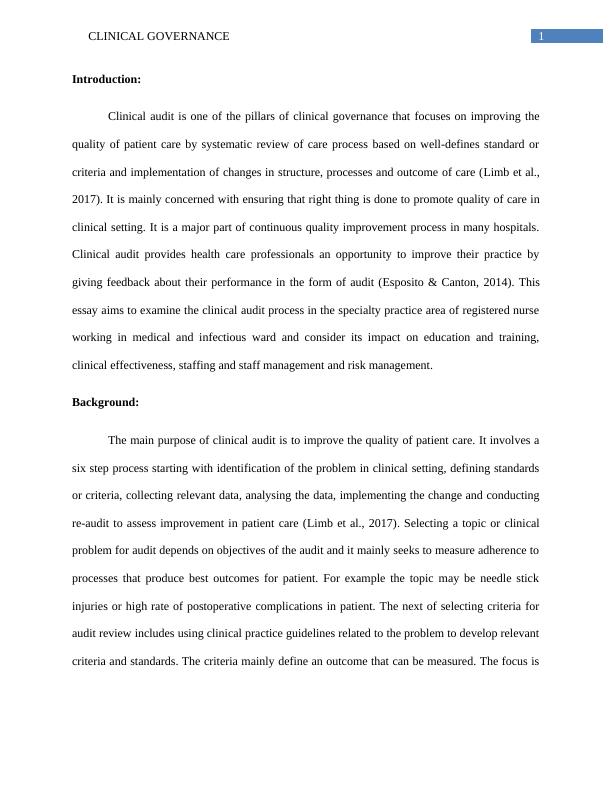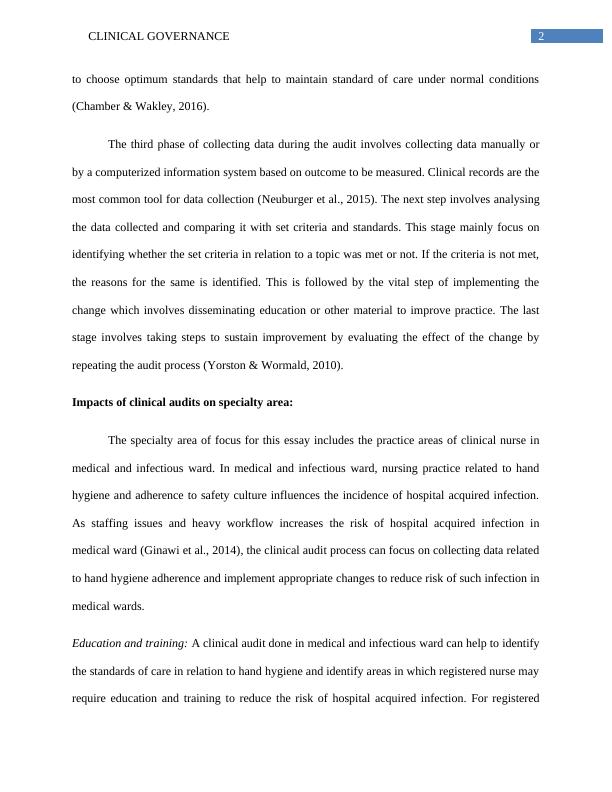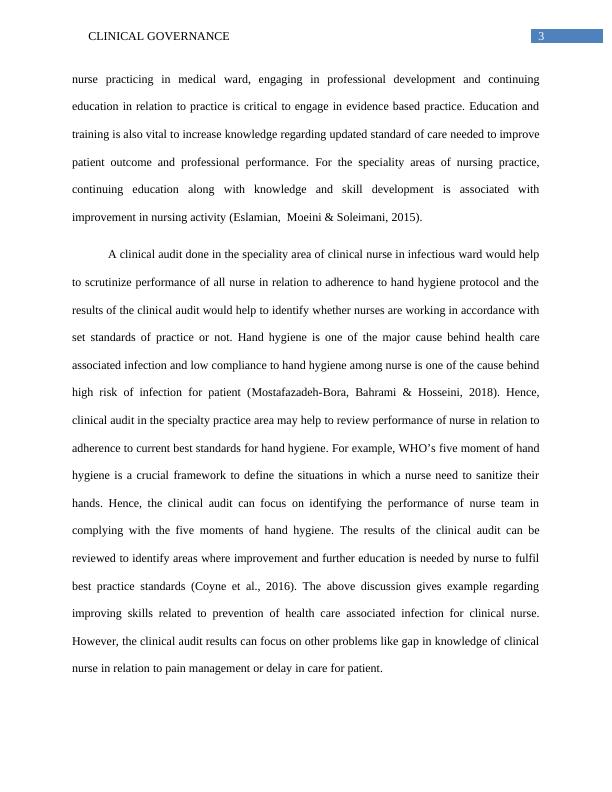Impact of Clinical Audit on Education, Clinical Effectiveness, Risk Management, and Staff Management in Medical and Infectious Ward
Added on 2023-01-13
13 Pages3484 Words24 Views
Running head: CLINICAL GOVERNANCE
Clinical governance
Name of the student:
Name of the University:
Author’s note
Clinical governance
Name of the student:
Name of the University:
Author’s note

1CLINICAL GOVERNANCE
Introduction:
Clinical audit is one of the pillars of clinical governance that focuses on improving the
quality of patient care by systematic review of care process based on well-defines standard or
criteria and implementation of changes in structure, processes and outcome of care (Limb et al.,
2017). It is mainly concerned with ensuring that right thing is done to promote quality of care in
clinical setting. It is a major part of continuous quality improvement process in many hospitals.
Clinical audit provides health care professionals an opportunity to improve their practice by
giving feedback about their performance in the form of audit (Esposito & Canton, 2014). This
essay aims to examine the clinical audit process in the specialty practice area of registered nurse
working in medical and infectious ward and consider its impact on education and training,
clinical effectiveness, staffing and staff management and risk management.
Background:
The main purpose of clinical audit is to improve the quality of patient care. It involves a
six step process starting with identification of the problem in clinical setting, defining standards
or criteria, collecting relevant data, analysing the data, implementing the change and conducting
re-audit to assess improvement in patient care (Limb et al., 2017). Selecting a topic or clinical
problem for audit depends on objectives of the audit and it mainly seeks to measure adherence to
processes that produce best outcomes for patient. For example the topic may be needle stick
injuries or high rate of postoperative complications in patient. The next of selecting criteria for
audit review includes using clinical practice guidelines related to the problem to develop relevant
criteria and standards. The criteria mainly define an outcome that can be measured. The focus is
Introduction:
Clinical audit is one of the pillars of clinical governance that focuses on improving the
quality of patient care by systematic review of care process based on well-defines standard or
criteria and implementation of changes in structure, processes and outcome of care (Limb et al.,
2017). It is mainly concerned with ensuring that right thing is done to promote quality of care in
clinical setting. It is a major part of continuous quality improvement process in many hospitals.
Clinical audit provides health care professionals an opportunity to improve their practice by
giving feedback about their performance in the form of audit (Esposito & Canton, 2014). This
essay aims to examine the clinical audit process in the specialty practice area of registered nurse
working in medical and infectious ward and consider its impact on education and training,
clinical effectiveness, staffing and staff management and risk management.
Background:
The main purpose of clinical audit is to improve the quality of patient care. It involves a
six step process starting with identification of the problem in clinical setting, defining standards
or criteria, collecting relevant data, analysing the data, implementing the change and conducting
re-audit to assess improvement in patient care (Limb et al., 2017). Selecting a topic or clinical
problem for audit depends on objectives of the audit and it mainly seeks to measure adherence to
processes that produce best outcomes for patient. For example the topic may be needle stick
injuries or high rate of postoperative complications in patient. The next of selecting criteria for
audit review includes using clinical practice guidelines related to the problem to develop relevant
criteria and standards. The criteria mainly define an outcome that can be measured. The focus is

2CLINICAL GOVERNANCE
to choose optimum standards that help to maintain standard of care under normal conditions
(Chamber & Wakley, 2016).
The third phase of collecting data during the audit involves collecting data manually or
by a computerized information system based on outcome to be measured. Clinical records are the
most common tool for data collection (Neuburger et al., 2015). The next step involves analysing
the data collected and comparing it with set criteria and standards. This stage mainly focus on
identifying whether the set criteria in relation to a topic was met or not. If the criteria is not met,
the reasons for the same is identified. This is followed by the vital step of implementing the
change which involves disseminating education or other material to improve practice. The last
stage involves taking steps to sustain improvement by evaluating the effect of the change by
repeating the audit process (Yorston & Wormald, 2010).
Impacts of clinical audits on specialty area:
The specialty area of focus for this essay includes the practice areas of clinical nurse in
medical and infectious ward. In medical and infectious ward, nursing practice related to hand
hygiene and adherence to safety culture influences the incidence of hospital acquired infection.
As staffing issues and heavy workflow increases the risk of hospital acquired infection in
medical ward (Ginawi et al., 2014), the clinical audit process can focus on collecting data related
to hand hygiene adherence and implement appropriate changes to reduce risk of such infection in
medical wards.
Education and training: A clinical audit done in medical and infectious ward can help to identify
the standards of care in relation to hand hygiene and identify areas in which registered nurse may
require education and training to reduce the risk of hospital acquired infection. For registered
to choose optimum standards that help to maintain standard of care under normal conditions
(Chamber & Wakley, 2016).
The third phase of collecting data during the audit involves collecting data manually or
by a computerized information system based on outcome to be measured. Clinical records are the
most common tool for data collection (Neuburger et al., 2015). The next step involves analysing
the data collected and comparing it with set criteria and standards. This stage mainly focus on
identifying whether the set criteria in relation to a topic was met or not. If the criteria is not met,
the reasons for the same is identified. This is followed by the vital step of implementing the
change which involves disseminating education or other material to improve practice. The last
stage involves taking steps to sustain improvement by evaluating the effect of the change by
repeating the audit process (Yorston & Wormald, 2010).
Impacts of clinical audits on specialty area:
The specialty area of focus for this essay includes the practice areas of clinical nurse in
medical and infectious ward. In medical and infectious ward, nursing practice related to hand
hygiene and adherence to safety culture influences the incidence of hospital acquired infection.
As staffing issues and heavy workflow increases the risk of hospital acquired infection in
medical ward (Ginawi et al., 2014), the clinical audit process can focus on collecting data related
to hand hygiene adherence and implement appropriate changes to reduce risk of such infection in
medical wards.
Education and training: A clinical audit done in medical and infectious ward can help to identify
the standards of care in relation to hand hygiene and identify areas in which registered nurse may
require education and training to reduce the risk of hospital acquired infection. For registered

3CLINICAL GOVERNANCE
nurse practicing in medical ward, engaging in professional development and continuing
education in relation to practice is critical to engage in evidence based practice. Education and
training is also vital to increase knowledge regarding updated standard of care needed to improve
patient outcome and professional performance. For the speciality areas of nursing practice,
continuing education along with knowledge and skill development is associated with
improvement in nursing activity (Eslamian, Moeini & Soleimani, 2015).
A clinical audit done in the speciality area of clinical nurse in infectious ward would help
to scrutinize performance of all nurse in relation to adherence to hand hygiene protocol and the
results of the clinical audit would help to identify whether nurses are working in accordance with
set standards of practice or not. Hand hygiene is one of the major cause behind health care
associated infection and low compliance to hand hygiene among nurse is one of the cause behind
high risk of infection for patient (Mostafazadeh-Bora, Bahrami & Hosseini, 2018). Hence,
clinical audit in the specialty practice area may help to review performance of nurse in relation to
adherence to current best standards for hand hygiene. For example, WHO’s five moment of hand
hygiene is a crucial framework to define the situations in which a nurse need to sanitize their
hands. Hence, the clinical audit can focus on identifying the performance of nurse team in
complying with the five moments of hand hygiene. The results of the clinical audit can be
reviewed to identify areas where improvement and further education is needed by nurse to fulfil
best practice standards (Coyne et al., 2016). The above discussion gives example regarding
improving skills related to prevention of health care associated infection for clinical nurse.
However, the clinical audit results can focus on other problems like gap in knowledge of clinical
nurse in relation to pain management or delay in care for patient.
nurse practicing in medical ward, engaging in professional development and continuing
education in relation to practice is critical to engage in evidence based practice. Education and
training is also vital to increase knowledge regarding updated standard of care needed to improve
patient outcome and professional performance. For the speciality areas of nursing practice,
continuing education along with knowledge and skill development is associated with
improvement in nursing activity (Eslamian, Moeini & Soleimani, 2015).
A clinical audit done in the speciality area of clinical nurse in infectious ward would help
to scrutinize performance of all nurse in relation to adherence to hand hygiene protocol and the
results of the clinical audit would help to identify whether nurses are working in accordance with
set standards of practice or not. Hand hygiene is one of the major cause behind health care
associated infection and low compliance to hand hygiene among nurse is one of the cause behind
high risk of infection for patient (Mostafazadeh-Bora, Bahrami & Hosseini, 2018). Hence,
clinical audit in the specialty practice area may help to review performance of nurse in relation to
adherence to current best standards for hand hygiene. For example, WHO’s five moment of hand
hygiene is a crucial framework to define the situations in which a nurse need to sanitize their
hands. Hence, the clinical audit can focus on identifying the performance of nurse team in
complying with the five moments of hand hygiene. The results of the clinical audit can be
reviewed to identify areas where improvement and further education is needed by nurse to fulfil
best practice standards (Coyne et al., 2016). The above discussion gives example regarding
improving skills related to prevention of health care associated infection for clinical nurse.
However, the clinical audit results can focus on other problems like gap in knowledge of clinical
nurse in relation to pain management or delay in care for patient.

End of preview
Want to access all the pages? Upload your documents or become a member.
Related Documents
Practice Evaluation Strategies - Clinical Audit Proposallg...
|13
|3479
|2
Clinical Audit: Definition, Process, Impact and Limitationslg...
|12
|3004
|274
Clinical Governance: Staffing and Clinical Auditlg...
|17
|4860
|37
Clinical Audit, The Process Of Inspection Of Datalg...
|6
|1389
|17
Clinical Audit Analysis 2022lg...
|14
|3343
|25
Early Strategic Management for Acute Heart Failure: A Quality Improvement Frameworklg...
|5
|556
|339
